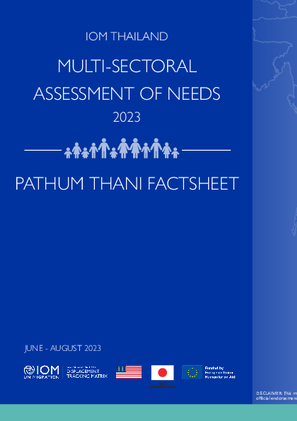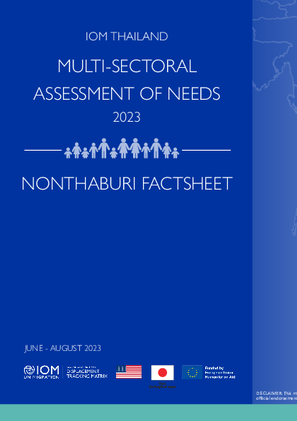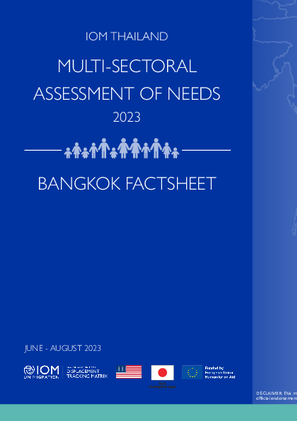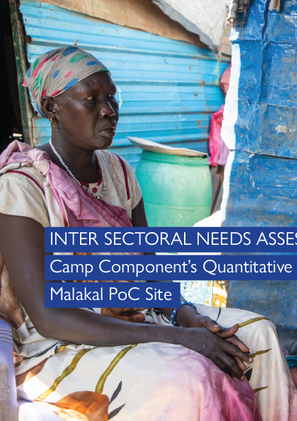-
Countries
-
Data and Analysis
-
Special Focus
-
Crisis Responses
Assessment Report

Contact
DTMBurundi@iom.int
Language
English
Location
Burundi
Period Covered
Mar 01 2023
Sep 30 2023
Activity
- Survey
En décembre 2022, une évaluation a été menée auprès des informateurs-clés pour renseigner sur la stabilité de 35 collines où se trouvent concurremment un grand nombre de personnes déplacées internes (PDI) et rapatriées provenant de cinq communes de la province de Cankuzo. Cet exercice nous a permis de déterminer, pour chaque colline, un score sur l’indice de stabilité (voir annexe 8.2). Cette méthode de collecte d’information est basée sur les perceptions d’informateurs-clés et peut donc être subjective aux informateurs eux-mêmes. En tenant compte de cette limitation et pour compléter les résultats de l’indice de stabilité, une évaluation du progrès vers une solution durable (voir annexe 8.2) a été menée auprès des ménages des collines de Bumba, Gitwenge et Nyuro à Gisagara. Cette évaluation a permis de comprendre les raisons qui sous-tendent le choix des lieux de retour ou de déplacement et les obstacles potentiels à la stabilisation des communautés accueillant les PDI et les rapatriés

Contact
DTMBurundi@iom.int
Language
English
Location
Burundi
Period Covered
Mar 01 2023
Mar 31 2023
Activity
- Survey
En décembre 2022, une évaluation a été menée auprès des informateurs-clés pour renseigner sur la stabilité de 64 collines où se trouvent concurremment un grand nombre de personnes déplacées internes (PDI) et rapatriées provenant de sept communes de la province de Kirundo. Cet exercice nous a permis de déterminer, pour chaque colline, un score sur l’indice de stabilité (voir annexe 8.2). Cette méthode de collecte d’information est basée sur les perceptions d’informateurs-clés et peut donc être subjective aux informateurs eux-mêmes. En tenant compte de cette limitation et pour compléter les résultats de l’indice de stabilité, une évaluation du progrès vers une solution durable (voir annexe 8.2) a été menée auprès des ménages des collines de Burara, Gatare et Gatete. Cette évaluation a permis de comprendre les raisons qui sous-tendent le choix des lieux de retour ou de déplacement et les obstacles potentiels à la stabilisation des communautés accueillant les PDI et les rapatriés.

Contact
DTM Peru, IOMDTMPeru@iom.int
Language
Spanish
Location
Peru
Period Covered
Jul 01 2023
Aug 31 2023
Activity
- Flow Monitoring
La Ronda 23 de la DTM Encuestas de caracterización (FMS por sus siglas en inglés) a personas refugiadas y migrantes de tránsito se llevó a cabo en julio y agosto de 2023. Sólo se aplicó a personas mayores de edad (18 años a más) los cuales dieron previo consentimiento pudiendo encuestar a un total de 260 personas. Esta DTM caracteriza a las poblaciones en movilidad y proporciona información cuantitativa sobre poblaciones en movimiento, tales como: distribución demográfica, motivos de desplazamiento, lugares de origen, necesidades inmediatas y perfil del grupo de viaje y de las niñas, niños y adolescentes (NNA).

Contact
DTMThailand@iom.int
Language
English
Location
Thailand
Period Covered
Jun 09 2023
Aug 27 2023
Activity
- Survey
- Site Assessment
This factsheet aims to provide a snapshot of multi-sectoral conditions, needs, and challenges among Myanmar migrants in Pathum Thani province as captured between June and August 2023 by IOM Thailand’s multisectoral assessment of needs. The purpose of this assessment is to provide insights regarding the severity of needs among migrant populations, identify vulnerable population groups and geographic areas with the most acute needs, inform assistance planning and relevant Sustainable Development Goals (SDGs) targets, and provide sectoral and inter-sectoral baselines for future assessments.

Contact
DTMThailand@iom.int
Language
English
Location
Thailand
Period Covered
Jun 09 2023
Aug 27 2023
Activity
- Survey
- Site Assessment
This factsheet aims to provide a snapshot of multi-sectoral conditions, needs, and challenges among Myanmar migrants in Nonthaburi province as captured between June and August 2023 by IOM Thailand’s multisectoral assessment of needs. The purpose of this assessment is to provide insights regarding the severity of needs among migrant populations, identify vulnerable population groups and geographic areas with the most acute needs, inform assistance planning and relevant Sustainable Development Goals (SDGs) targets, and provide sectoral and inter-sectoral baselines for future assessments.

Contact
DTMThailand@iom.int
Language
English
Location
Thailand
Period Covered
Jun 09 2023
Aug 27 2023
Activity
- Survey
- Site Assessment
This factsheet aims to provide a snapshot of multi-sectoral conditions, needs, and challenges among Myanmar migrants in the Greater Bangkok Area as captured between June and August 2023 by IOM Thailand’s multisectoral assessment of needs. The purpose of this assessment is to provide insights regarding the severity of needs among migrant populations, identify vulnerable population groups and geographic areas with the most acute needs, inform assistance planning and relevant Sustainable Development Goals (SDGs) targets, and provide sectoral and inter-sectoral baselines for future assessments.

Contact
DTMThailand@iom.int
Language
English
Location
Thailand
Period Covered
Jun 09 2023
Aug 27 2023
Activity
- Survey
- Site Assessment
This factsheet aims to provide a snapshot of multi-sectoral conditions, needs, and challenges among Myanmar migrants in Bangkok province as captured between June and August 2023 by IOM Thailand’s multi-sectoral assessment of needs. The purpose of this assessment is to provide insights regarding the severity of needs among migrant populations, identify vulnerable population groups and geographic areas with the most acute needs, inform assistance planning and relevant Sustainable Development Goals (SDGs) targets, and provide sectoral and inter-sectoral baselines for future assessments.

Contact
DTM South Sudan, SouthSudanDTM@iom.int
Language
English
Location
South Sudan
Period Covered
Sep 01 2022
Oct 31 2022
Activity
- Survey
- Return Intention
Between September and October 2022, the International Organization for Migration’s Displacement Tracking Matrix (IOM DTM) undertook its third household-level multi-sector assessment of selected urban areas and camps for internally displaced persons (IDPs) in South Sudan. The assessment aims to:
• Quantify the prevalence of vulnerabilities and humanitarian needs across sectors, with a focus on food security, economic vulnerability and nutrition as well as selected indicators on shelter and non-food items (SNFI), education, health, water, hygiene and sanitation (WASH), protection (including child protection and gender-based violence) and mental health and psycho-social support (MHPSS).
• Generate a better understanding of urban displacement and migration, including return and relocation after displacement in South Sudan or abroad.
There has been slow progress in the humanitarian situation in South Sudan. People’s humanitarian needs continue to rise, driven by cumulative and compounding effects of years of conflict, sub-national violence, food insecurity, climate crisis and public health challenges. Conflict and insecurity, fueled by sub-national and inter-communal violence, crime, and wide-scale impunity, continue to be among the main drivers of humanitarian needs in South Sudan.
Based on the request of the Humanitarian Country Team (HCT), mandated OCHA, IOM, and REACH to implement Inter-Sectoral Needs Assessment that aimed to understand demographics, multi-sectoral needs (including the level of severity) and barriers to assistance as well as displacement patterns and household-level scale.

Contact
DTM South Sudan, SouthSudanDTM@iom.int
Language
English
Location
South Sudan
Period Covered
Sep 01 2022
Oct 31 2022
Activity
- Survey
- Return Intention
Between September and October 2022, the International Organization for Migration’s Displacement Tracking Matrix (IOM DTM) undertook its third household-level multi-sector assessment of selected urban areas and camps for internally displaced persons (IDPs) in South Sudan. The assessment aims to:
• Quantify the prevalence of vulnerabilities and humanitarian needs across sectors, with a focus on food security, economic vulnerability and nutrition as well as selected indicators on shelter and non-food items (SNFI), education, health, water, hygiene and sanitation (WASH), protection (including child protection and gender-based violence) and mental health and psycho-social support (MHPSS).
• Generate a better understanding of urban displacement and migration, including return and relocation after displacement in South Sudan or abroad.
There has been slow progress in the humanitarian situation in South Sudan. People’s humanitarian needs continue to rise, driven by cumulative and compounding effects of years of conflict, sub-national violence, food insecurity, climate crisis and public health challenges. Conflict and insecurity, fueled by sub-national and inter-communal violence, crime, and wide-scale impunity, continue to be among the main drivers of humanitarian needs in South Sudan.
Based on the request of the Humanitarian Country Team (HCT), mandated OCHA, IOM, and REACH to implement Inter-Sectoral Needs Assessment that aimed to understand demographics, multi-sectoral needs (including the level of severity) and barriers to assistance as well as displacement patterns and household-level scale.

Contact
DTM South Sudan, SouthSudanDTM@iom.int
Language
English
Location
South Sudan
Period Covered
Sep 01 2022
Oct 31 2022
Activity
- Survey
- Return Intention
Between September and October 2022, the International Organization for Migration’s Displacement Tracking Matrix (IOM DTM) undertook its third household-level multi-sector assessment of selected urban areas and camps for internally displaced persons (IDPs) in South Sudan. The assessment aims to:
• Quantify the prevalence of vulnerabilities and humanitarian needs across sectors, with a focus on food security, economic vulnerability and nutrition as well as selected indicators on shelter and non-food items (SNFI), education, health, water, hygiene and sanitation (WASH), protection (including child protection and gender-based violence) and mental health and psycho-social support (MHPSS).
• Generate a better understanding of urban displacement and migration, including return and relocation after displacement in South Sudan or abroad.
There has been slow progress in the humanitarian situation in South Sudan. People’s humanitarian needs continue to rise, driven by cumulative and compounding effects of years of conflict, sub-national violence, food insecurity, climate crisis and public health challenges. Conflict and insecurity, fueled by sub-national and inter-communal violence, crime, and wide-scale impunity, continue to be among the main drivers of humanitarian needs in South Sudan.
Based on the request of the Humanitarian Country Team (HCT), mandated OCHA, IOM, and REACH to implement Inter-Sectoral Needs Assessment that aimed to understand demographics, multi-sectoral needs (including the level of severity) and barriers to assistance as well as displacement patterns and household-level scale.
Pagination
- Previous page
- Page 72
- Next page
